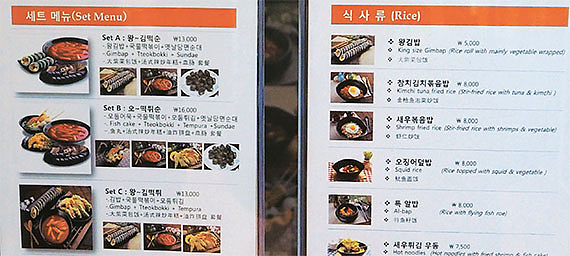Olympic dishes are delicious, but hard to describe

A menu at a Hoenggye Village, Pyeongchang County, Gangwon, restaurant offers romanization of Korean dishes such as gimbap and tteokbokki. The menu on the right lists fish egg rice as al-bap. [KIM WON]
Romanization of Korean dishes such as tteokbokki, sundae and gimbap was featured on one restaurant menu in Hoenggye Village, Pyeongchang County, Gangwon, on April 13.
The opening and closing ceremonies for the PyeongChang Olympics will take place at Hoenggye. Forty-one out of 102 Olympic events will take place there for bobsledding, ski jumping and alpine skiing events. However, the restaurants in the area are ill-prepared for the more than 100,000 visitors expected.
Restaurants near the Hoenggye Intercity Bus Terminal had a noticeable dearth of English-language menus, except for the larger 50-seat establishments. Even when smaller restaurants offered English language menus, their items were translated inconsistently.
One restaurant wrote “pork belly” for samgyeopsal and another wrote “pork loin.” Another was satisfied using Korean romanization for beef short ribs soup, using galbitang.
Not a single restaurant provided an explanation of their menus in English. Restaurant placards in English were nowhere to be seen. A tiny “Korean Restaurant” in English, affixed to some Korean language restaurant signs, was all.
The Gangwon provincial government and Pyeongchang County are focusing on providing English language menus in preparation for the Olympics.
Gangwon has provided 1,000 restaurants with English language menus in 18 cities and counties within the province in cooperation with the Korea Tourism Organization so far since last year.
The idea is to have 2,000 restaurants in six cities, such as Gangneung and Pyeongchang, offering English menus within the year. But the effectiveness of this plan is questionable as the number of restaurants providing menus or in-depth explanations of menu items remains low.
“Even if there was an English menu, there’s a limit to explanations,” said one employee at an Hoenggye Village restaurant. “When we receive foreign customers, I always check to see if there’s a guide who can interpret.”
“The plan is to have volunteer interpreters placed at several locations in the area during the Olympic period,” said Jeong Mun-jun, an official at the Gangwon provincial government, “and operate a call-center for English, Chinese, Russian and Japanese interpretation.”
In the case of restaurants in Pyeongchang and Jeongseon, another issue is that many restaurants feature regional specialties such as hwangtaegui (spicy grilled pollack), which are unfamiliar to most foreigners.
“It was stressful to eat Korean food every day. Except for bread, it was difficult to find anything to eat at Hoenggye Village,” said an official from the Russian national ski team as he recounted his experiences from his stay for the Olympic test events.
“During the test events, foreign tourists asked me to introduce restaurants to them,” said Kim Ik-rae, a Hoenggye Village taxi driver, “but a specific restaurant didn’t come to mind. Because I couldn’t take them to barbecue places selling hanwoo [Korean beef] all the time, it was embarrassing.”
One possible solution is to use food trucks. PyeongChang County’s council passed an ordinance regarding the operation of food trucks last November.
Food trucks made an entrance selling fish cakes, kebabs, and roasted chestnuts during the test events held at Gangneung and at the PyeongChang Phoenix Snow Park on February.
“This is an issue where a [food court] for foreign tourists must be concentrated with restaurants offering English language menus,” said Choi Won-ho, sports analyst.
“The Olympic organization committee or Gangwon provincial government must meticulously prepare for these areas.”
The Gangwon provincial government is also in the process of renovating facilities to include Western-style seats and tables and toilets for the Olympics.
Gangwon is injecting a sum of 11.98 billion won ($10.46 million) for “Olympic Restaurants.” Each business will be allotted 700 million won for these renovations.
“It was difficult to adjust to having to sit cross-legged on the floor to eat on Korean tables,” said a staff member at Ski Jump World Cup, John Guester. “I had to stand up even though I wasn’t finished with my meal because my legs hurt.”
But from the perspective of business owners, remodeling for the Olympics is unpalatable as financial support is incommensurate to the additional expense of the required renovations.
“After thinking of fixing one thing and another, the costs snowballed,” one restaurant owner said. “Because the financial support doesn’t amount to much, it isn’t easy to have large-scale construction.”
BY KIM JI-HAN, KIM WON [hwang.hosub@joongang.co.kr]










with the Korea JoongAng Daily
To write comments, please log in to one of the accounts.
Standards Board Policy (0/250자)